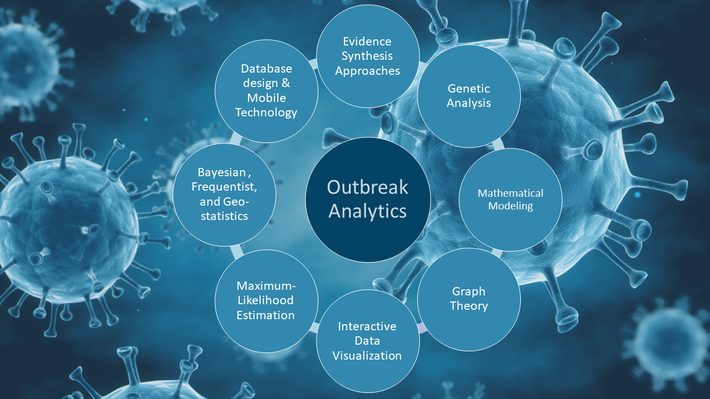 Epidemics remain a major public health issue.
Epidemics remain a major public health issue. - Data science steps in when traditional modeling methods fail.
- Outbreak analytics can handle the complex data involved in pandemic assessment.
The last two decades saw more new infectious diseases of global concern than in any similar period of history [1]. Ebola, Influenza A (H1N1), SARS, MERS, Zika virus were all of concern, but it wasnt until the COVID-19 pandemic hit full force that the world became acutely aware of the inadequacy of the traditional outbreak response system. Despite officials best efforts to contain the Covid-19 outbreak, the traditional methodssurveillance, response, and managementfailed to address ample warnings, in part because of inadequate procedures for handling diverse data.
The successful investigation and containment of infectious disease outbreaks relies on analyzing complex and diverse data sources. Analysis of this data can only be achieved by a multidisciplinary approach, using several different, complementary approaches and tools including outbreak analytics. Clinical researchers and medical professionals around the globe joined forces to find ways to handle complex data, open-source data, and work collaboratively on improvements to the system [2].
An Overview of Outbreak Analytics
Outbreak analytics was developed to focuses on the technological and methodological aspects of the outbreak data pipeline from data collection to informing outbreak response. It sits at the crossroads of data science and a variety of public health fields including planning, field epidemiology and methodological development. Outbreak analytics is part of an overall prevention and control plan that includes several other core pillars of outbreak response including case management, surveillance and contact tracing, logistics, and testing [3].
The interdisciplinary field uses data science methods from a variety of perspectives to inform outbreak response, including [4]:
- Bayesian statistics,
- Database design and mobile technology,
- Evidence synthesis approaches,
- Frequentist statistics,
- Geostatistics,
- Graph theory,
- Interactive data visualization,
- Mathematical modelling,
- Maximum-likelihood estimation,
- Genetic analysis.
It can help to answer questions like [4]:
- What are mortality and risk factors?
- Could a rapid test help reduce incidence?
- Which is the optimal vaccination strategy?
- Should international travel be restricted?
- Has the delay between symptom onset and hospitalization been reduced?
Despite many advances in outbreak analysis over the last 18 months, like contact tracing, pandemic modeling and risk assessment, adoption of outbreak analytics has been at a snail’s pace. A unified platform for the analysis of disease outbreaks is still lacking [5].
The Future of Outbreak Analytics
The emergence of outbreak analytics highlights the need for freely available, high-quality, and open-source methods for handling infectious disease outbreaks. While not yet fully recognized as a field deserving of recognition and support [6], its likely that the development of outbreak analytics will continue to grow. Many agencies including the World Health Organization and UNICEF have already implemented outbreak analytics into their programs. Earlier this year, a major step towards recognition was made when the Assistant to the President for National Security Affairs (APNSA), in coordination with various other coordinators and agencies, were directed by the Whitehouse to develop a plan for establishing an interagency National Center for Epidemic Forecasting and Outbreak Analytics [7]. Going forward, as globalization leads to increasing pandemic risk, expect to hear a lot more about this emerging field of data science.
References
Image: Author
[1] To Prevent Future Pandemics, The U.S. Should Invest In Real-Time R…
[2] How Data Science Helped Combat the Coronavirus Outbreak
[3] Back to basics: the outbreak response pillars
[4] Outbreak analytics: a developing data science for informing the res…
[5] OutbreakTools: A new platform for disease outbreak analysis using t…
[6] Why development of outbreak analytics tools should be valued, suppo…
[7] National Security Memorandum on United States Global Leadership to …

 Epidemics remain a major public health issue.
Epidemics remain a major public health issue.